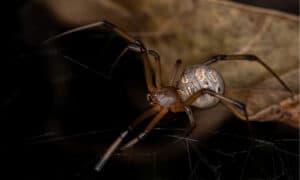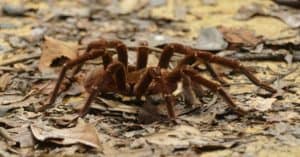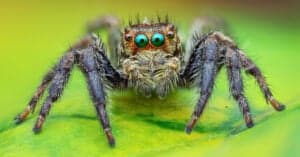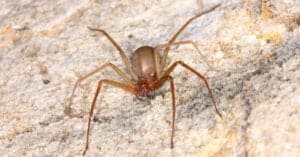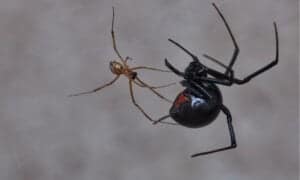Discover The Largest Huntsman Spider Ever Recorded!
@media (min-width: 481px) {
.mobile-top-content {
display: none;
}
}
#mobileTopContentCTACarouselControls { overflow: hidden; text-overflow: ellipsis; white-space: nowrap; }
.mobile-top-content .more { color: #fff; }
.mobile-top-content a { color: #fff; text-decoration: underline; }
.mobile-top-content a:hover { color: #fff; text-decoration: underline; }
@media (max-width: 480px) {
.mobile-top-content {
background-color: #06a10b;
color: #fff;
text-align: center;
/*height: 60px;
padding-top:5px;*/
font-size:80%;
/* display: block; */
margin: 0px -30px;
}
}
Sparassidae, the family which includes the huntsman spiders, currently contains 1,383 different species. The Giant huntsman, on the other hand, is the family’s largest member. In terms of leg span, huntsman spiders are the biggest spiders in the world. Crab or wood spiders are other names for this diversified species, which is commonly described as a “huntsman” because of their speed and hunting style. They are often mistaken for baboon spiders but are not related to each other.
Even though huntsman spiders are feared by many people because of their enormous size, they’re actually fairly placid and docile. The average huntsman spider is only about 1 inch long with a 5-inch leg span. However, some tend to grow much larger than this! So, what is the largest of these gentle giants that have ever been measured? Let’s find out!
Largest Huntsman Spider Ever Recorded
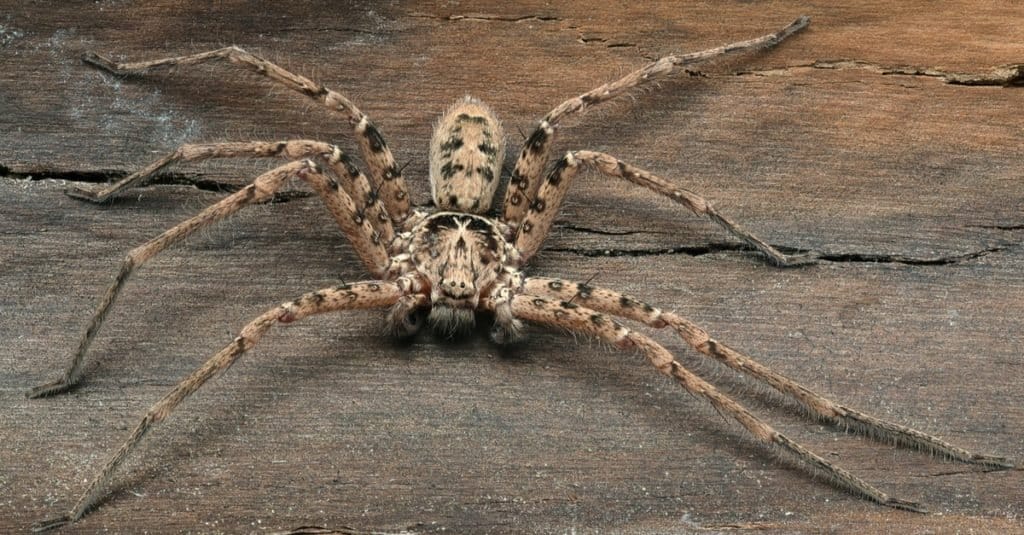
iSKYDANCER/Shutterstock.com
The largest-ever documented huntsman spider had a leg span of 30 cm (12 in) leg span and 4.6 cm (1.8 in) body length. However, Charlotte, a Giant huntsman Spider, was rescued by Barnyard Betty’s Rescue farm and refuge in Queensland, Australia, in October 2015. Even though the farm did not measure Charlotte, many people believe she broke this record for the largest huntsman spider, although many experts say she probably had around a 20 cm leg span. The gargantuan arachnid reportedly grew to frightening proportions by scavenging for bugs in a long-abandoned farmer’s shed, safe from predators.
About Huntsman Spiders

Peter Yeeles/Shutterstock.com
Appearance
The huntsman spider has eight eyes. The eyes are in two rows of four, pointing front. In Laos, male giant huntsman spiders reach a leg span of (9.8–11.8 in). The legs of huntsman spiders are twisted in such a way that they extend forward like a crab, hence the nickname “crab” spider. Their tops are brown or grey. Many species have black-and-white undersides with reddish mouthpart spots. Their legs have spines, but their bodies are smooth and fuzzy.
Certain Huntsman spider sub-species vary in appearance. For example, the banded huntsman (Holconia) is huge and has striped legs. Neosparassus is larger, brown, and hairier. Also, large, and hairy, with brown, white, and black markings, the tropical huntsman (Heteropoda).
Habitat
Huntsman species can be found in nearly every mild temperate to tropical region on Earth, including much of Australasia; Africa; Asia; the Mediterranean; and the Americas. Several species, such as the green huntsman spider, are native to colder areas, such as Northern and Central Europe. Many subtropical regions of the world, including New Zealand, have been colonized by tropical species like the cane huntsman and the social huntsman. Southern Florida is home to invasive huntsman spiders, brought over from Asia.
Huntsman spiders are most often encountered in sheds, garages, and other less-frequently disturbed places where they reside behind rocks, bark, and other similar covers. Cockroaches and other pests can be a meal for them if they find their way into an unclean house.
Diet
As adults, huntsman spiders do not spin webs, but hunt and search for food. Their diet consists mostly of insects and other invertebrates, and sometimes tiny lizards and geckos. They reside in the fissures of trees but because of their quickness, they hunt and devour fast bugs cockroaches and end up in people’s homes!
Danger
Huntsman spiders have venom that they use to catch and kill prey. When a huntsman spider attacks and bites a human or a pet, it is not always clear what causes them to do so. Females are known to guard their egg sacs and young vigorously when perceived threats arise. Another possibility is that the spider was mistreated or harassed in some way. Once threatened, they may attack or bite, depending on the severity of the situation.
Huntsman spiders are known for their speed and agility and can even walk on walls and ceilings. They also tend to demonstrate a “cling” reaction, making it difficult to shake them off and more prone to bite if they are picked up. Symptoms of a huntsman bite include regional pain and swelling, but they are rarely life-threatening. Huntsman spiders are rarely severe enough to necessitate medical attention.
In Conclusion

Pong Wira/Shutterstock.com
To properly appreciate the huntsman, one must be willing to go past the stigma and phobia of spiders. Despite their size, most spiders aren’t aggressive, preferring to go about their job of eating bugs and thriving in peace. This gentle giant is no different! During the summer, female huntsman spiders can become more aggressive in order to protect their egg sacs. However, unless they are provoked, they are more likely to flee than to attack.
More from A-Z Animals
.more-snake-card-image { max-height:140px !important; }
@media (min-width: 481px) {
.mobile-top-content {
display: none;
}
}
#mobileTopContentCTACarouselControls { overflow: hidden; text-overflow: ellipsis; white-space: nowrap; }
.mobile-top-content .more { color: #fff; }
.mobile-top-content a { color: #fff; text-decoration: underline; }
.mobile-top-content a:hover { color: #fff; text-decoration: underline; }
@media (max-width: 480px) {
.mobile-top-content {
background-color: #06a10b;
color: #fff;
text-align: center;
/*height: 60px;
padding-top:5px;*/
font-size:80%;
/* display: block; */
margin: 0px -30px;
}
}
Sparassidae, the family which includes the huntsman spiders, currently contains 1,383 different species. The Giant huntsman, on the other hand, is the family’s largest member. In terms of leg span, huntsman spiders are the biggest spiders in the world. Crab or wood spiders are other names for this diversified species, which is commonly described as a “huntsman” because of their speed and hunting style. They are often mistaken for baboon spiders but are not related to each other.
Even though huntsman spiders are feared by many people because of their enormous size, they’re actually fairly placid and docile. The average huntsman spider is only about 1 inch long with a 5-inch leg span. However, some tend to grow much larger than this! So, what is the largest of these gentle giants that have ever been measured? Let’s find out!
Largest Huntsman Spider Ever Recorded

iSKYDANCER/Shutterstock.com
The largest-ever documented huntsman spider had a leg span of 30 cm (12 in) leg span and 4.6 cm (1.8 in) body length. However, Charlotte, a Giant huntsman Spider, was rescued by Barnyard Betty’s Rescue farm and refuge in Queensland, Australia, in October 2015. Even though the farm did not measure Charlotte, many people believe she broke this record for the largest huntsman spider, although many experts say she probably had around a 20 cm leg span. The gargantuan arachnid reportedly grew to frightening proportions by scavenging for bugs in a long-abandoned farmer’s shed, safe from predators.
About Huntsman Spiders

Peter Yeeles/Shutterstock.com
Appearance
The huntsman spider has eight eyes. The eyes are in two rows of four, pointing front. In Laos, male giant huntsman spiders reach a leg span of (9.8–11.8 in). The legs of huntsman spiders are twisted in such a way that they extend forward like a crab, hence the nickname “crab” spider. Their tops are brown or grey. Many species have black-and-white undersides with reddish mouthpart spots. Their legs have spines, but their bodies are smooth and fuzzy.
Certain Huntsman spider sub-species vary in appearance. For example, the banded huntsman (Holconia) is huge and has striped legs. Neosparassus is larger, brown, and hairier. Also, large, and hairy, with brown, white, and black markings, the tropical huntsman (Heteropoda).
Habitat
Huntsman species can be found in nearly every mild temperate to tropical region on Earth, including much of Australasia; Africa; Asia; the Mediterranean; and the Americas. Several species, such as the green huntsman spider, are native to colder areas, such as Northern and Central Europe. Many subtropical regions of the world, including New Zealand, have been colonized by tropical species like the cane huntsman and the social huntsman. Southern Florida is home to invasive huntsman spiders, brought over from Asia.
Huntsman spiders are most often encountered in sheds, garages, and other less-frequently disturbed places where they reside behind rocks, bark, and other similar covers. Cockroaches and other pests can be a meal for them if they find their way into an unclean house.
Diet
As adults, huntsman spiders do not spin webs, but hunt and search for food. Their diet consists mostly of insects and other invertebrates, and sometimes tiny lizards and geckos. They reside in the fissures of trees but because of their quickness, they hunt and devour fast bugs cockroaches and end up in people’s homes!
Danger
Huntsman spiders have venom that they use to catch and kill prey. When a huntsman spider attacks and bites a human or a pet, it is not always clear what causes them to do so. Females are known to guard their egg sacs and young vigorously when perceived threats arise. Another possibility is that the spider was mistreated or harassed in some way. Once threatened, they may attack or bite, depending on the severity of the situation.
Huntsman spiders are known for their speed and agility and can even walk on walls and ceilings. They also tend to demonstrate a “cling” reaction, making it difficult to shake them off and more prone to bite if they are picked up. Symptoms of a huntsman bite include regional pain and swelling, but they are rarely life-threatening. Huntsman spiders are rarely severe enough to necessitate medical attention.
In Conclusion

Pong Wira/Shutterstock.com
To properly appreciate the huntsman, one must be willing to go past the stigma and phobia of spiders. Despite their size, most spiders aren’t aggressive, preferring to go about their job of eating bugs and thriving in peace. This gentle giant is no different! During the summer, female huntsman spiders can become more aggressive in order to protect their egg sacs. However, unless they are provoked, they are more likely to flee than to attack.

